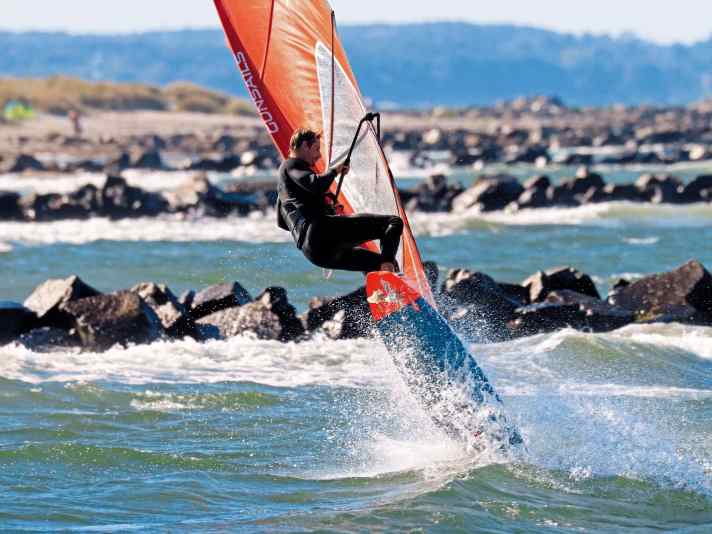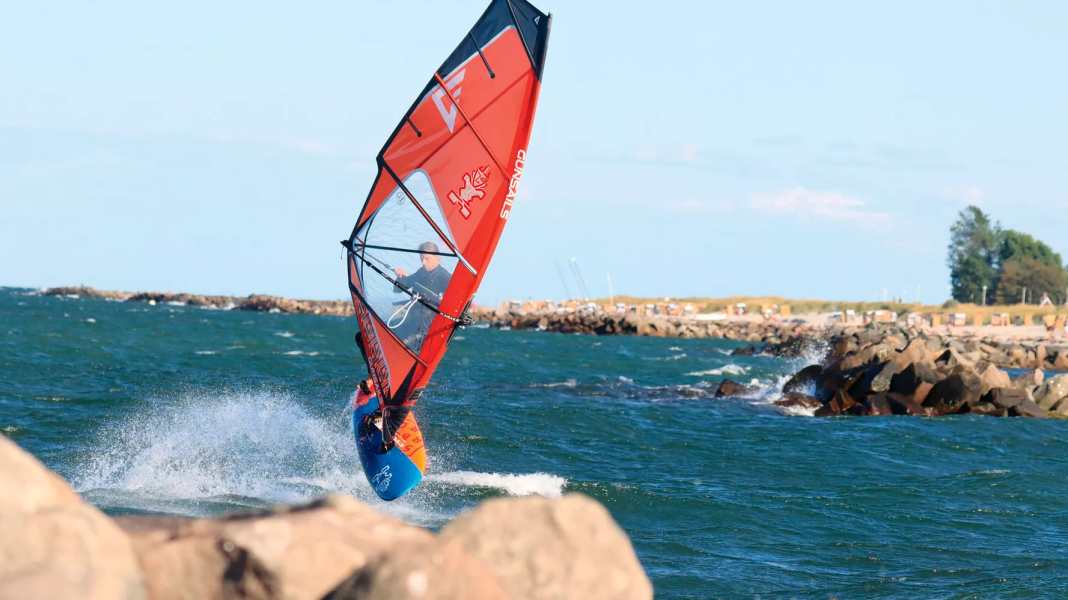
In this article:
Safety first
The spin loop is first and foremost a matter of the head. On the one hand, because the head controls the rotation - more on this later. On the other hand, because the mental cinema is usually running at full speed before the first loop: "Isn't that dangerous? Can you hurt yourself?" - questions like these are on everyone's mind.
However, experience from many loop courses has also shown that the risk of injury when looping is not exceptionally high - with one exception: occasional injuries to the ear and eardrum cannot be dismissed out of hand. For this reason, it is advisable to use earplugs when practising spin looping. Positive side effect: these also protect against the "Surfers Ear" a slow ossification of the ear canals due to the recurring entry of cold water.
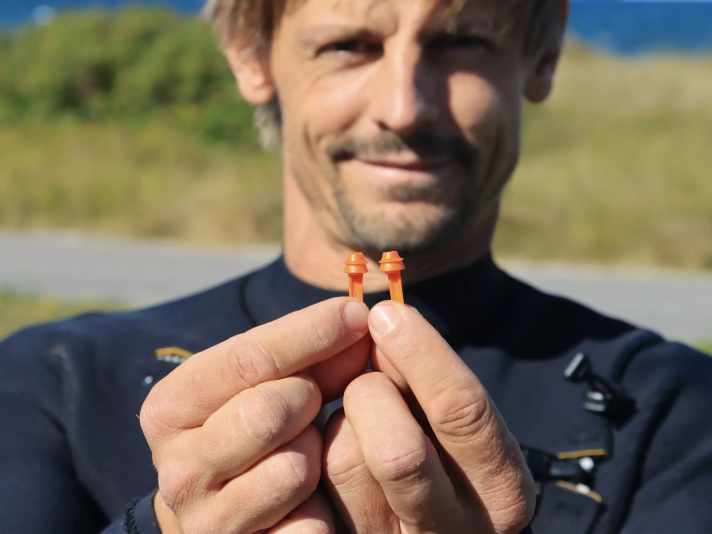
As an alternative or in addition to earplugs, you should consider wearing a water sports helmet. Not because head injuries are particularly common when learning the loop, but first and foremost because you can usually successfully pull the plug on the head cinema and tackle the spin loop mission with more courage and self-confidence.
The right material setup
If you want to learn the spin loop, the best way to do this is with a light wave or freemove sail. Camber sails are a no-go. The ideal wind range is between 20 and 30 knots, you should be well powered up but not overpowered and the sail should ideally be no larger than 5.7 square metres. Wave, freestyle wave or small freemove boards with a volume of less than 115 litres are best.
A tip for the fin setupA reasonably free glide and sufficient speed are important to avoid getting stuck on take-off. So if you have the opportunity to switch from a twinser or quad setup to a setup with a large centre fin (as a thruster or single fin), you will benefit noticeably.
Our photo rider Flo Jung, who has been teaching the loop in his wave camps for years, knows another sticking point: "It happens again and again that loop aspirants lose the board when turning in. Especially if the loops offer too little lateral support. For narrow feet, you can tighten the loops by using dowels that don't actually belong together."
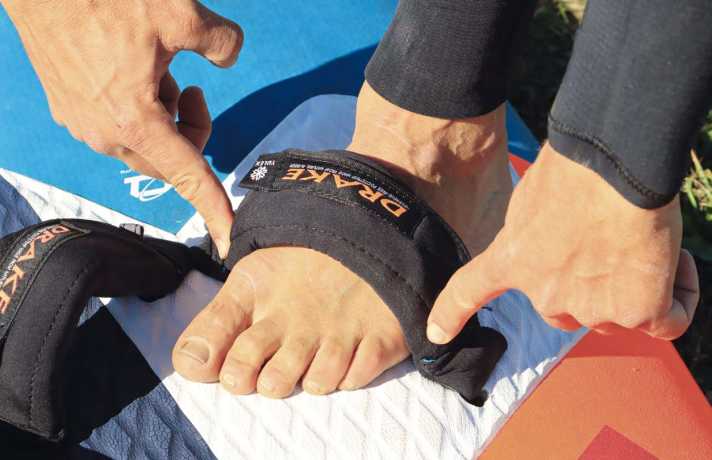
The best pre-exercises for the spin loop
You can even approach the spin loop step by step - and quite safely. Almost the entire rotation technique can be practised 1:1 without jumping. This not only burns the technique into your memory, but you also gradually lose respect for the unfamiliar rotation.
The spin loop is not a forward somersault, but rather a sideways rotation." (Flo Jung)
From killer to control: the history of the front loop
The early 90s were the golden age of windsurfing - the duels between Robby Naish, Björn Dunkerbeck, Josh Angulo and Robert Teriitehau are unforgettable. One of the "big moves" at the time was the "killer loop", a front loop that went completely over the top. The killer loop owed its name to the fact that the pilot only saw the landing point at the very end - which led to many crash landings and destroyed boards.
In the years that followed, a different loop technique with a more upright axis of rotation and consequently lateral rotation became established, which is still the measure of all things today. The advantage of this is that the pilot can see the water during virtually the entire rotation and can also stop or accelerate the rotation in a controlled manner. Without this technique, neither the towering, delayed forwards nor the controlled double loops that are now part of the elite's repertoire in the World Cup would be possible. And the spin loop jumped on shallow water also works with this technique - a jump height of just 50 centimetres is enough to rotate without water contact.
No other jump in windsurfing has such a high wow factor as the spin loop.
Basics for the spin loop
Put simply, the spin loop is initiated by moving the sail forwards and pulling the sail hand extremely tight. In doing so, you look backwards towards the end of the boom and support the rotation.
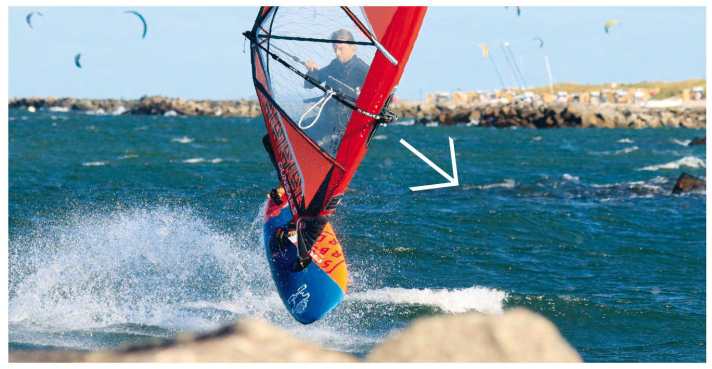
Pre-exercise 1: Rotation with sail only
In wind forces of three to five you can only simulate turning in with the rig. To do this, find a place where you can set the sail on a sandy surface in water that is about knee-deep. Spots where the wind blows offshore over the beach or a sandbank and behind which it gets deep quickly are perfect. Be sure to pay attention: Make sure that there are no obstacles, other surfers, shallow spots or even stones in the water downwind where you could injure yourself! Position yourself in the normal riding position and check the free space downwind.
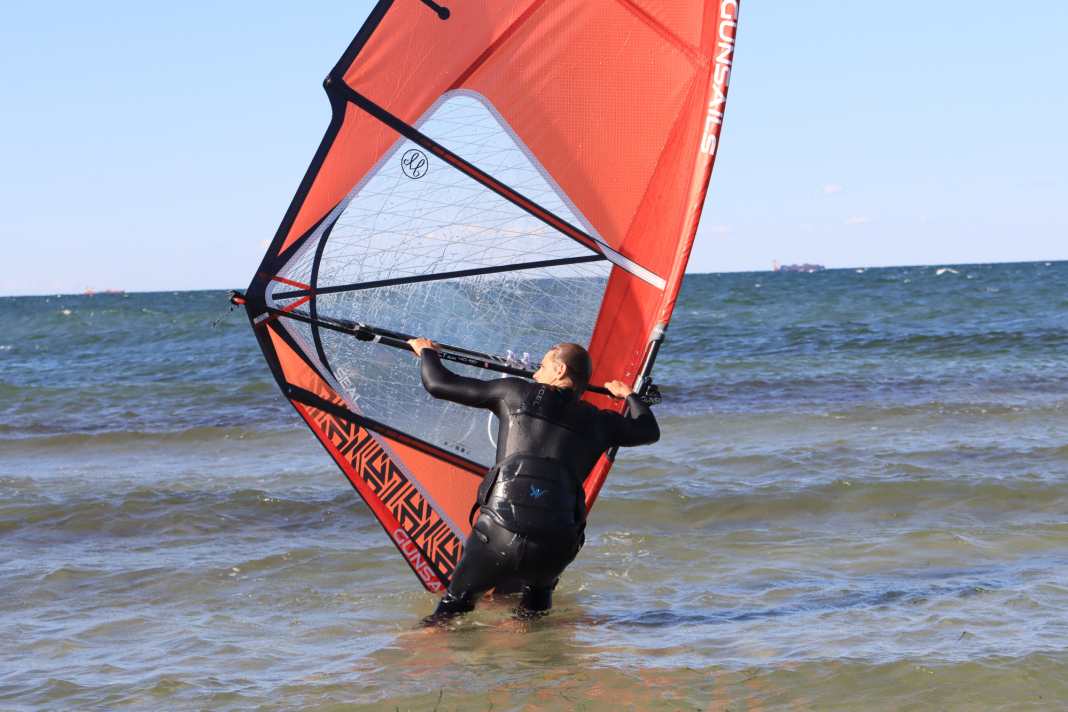




Pre-exercise 2: Loops from the longboard
If you have already done exercise 1, or the local conditions (e.g. stony ground) do not allow it, you can also practise the same technique from a longboard or wind SUP. Two to four wind forces and a handy wave sail are ideal. Gain momentum on a light, room wind course. Push the sail hand far back.
Jump lightly off the board and pull fully tight with your sailing hand. Again, turn your head so that you can watch your sailing hand as you pull tight and let the sail whirl you around. Ideally, you will land on your back in the water under the sail after half to three quarters of a rotation.
How to do the spin loop while windsurfing
The pre-exercises shown for the spin loop only bring a tired smile to your face? And even the normal jumps from the first part of the Frontloop series are no problem for you? Then you're ready for the complete spin loop.
The helmet fits, the wind is peppering and you are motivated to the tips of your toes? Treat yourself to a few test strokes to see if your sail fits. Ideally, you should have 20 to 30 knots of wind and a sail that is powered up but not overpowered. If a few small chops or swells get in the way, you're ready to go.
The spin loop step by step
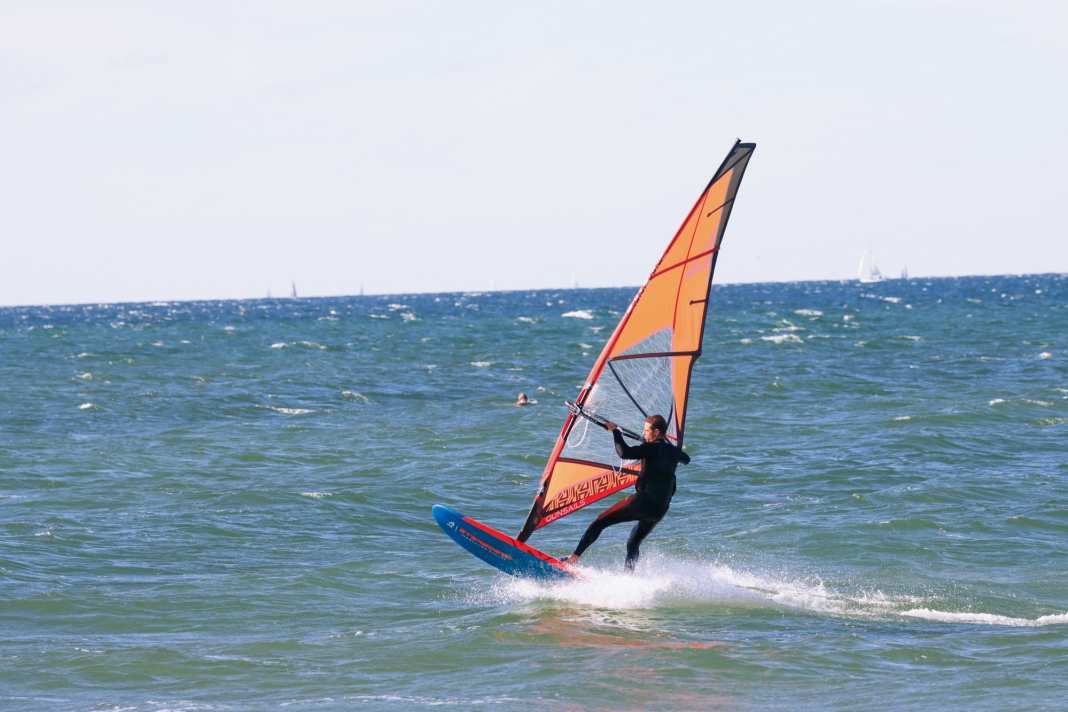





If you can see your back hand when rotating, you're doing a lot of things right!
Only when you are turning in over bigger ramps and have more jumping height is it time to control the landing phase more consciously. In the third and final part of the front loop series in surf 1-2/2023 and soon here on surf-magazin.de, we will show you how to master the transition from the spin loop to the (delayed) front loop!
Tips and tricks for the spin loop
Spinlooping with a plan
At this point, I would like to take up the cudgels once again for all the Camps, riding technique clinics and loop challenges . In addition to the helpful tips from the coaches, they fulfil an even more important purpose: they provide the sometimes necessary "kick in the arse" that lets you pull through in the end. Of course, motivated friends will also do the trick, cheering you on for a lap - and preferably joining in right away! We can promise you one thing - from our own experience and as observers: if you manage to pull through once and do your first loop, you will never forget that moment again. You'll cheer like a little kid - and do it again and again.
Screw instead of somersault
How steep or flat you rotate depends on how the sail is shifted when turning in. If the mast tilts to leeward over the board, you rotate vertically - and quickly get caught with the top. Ideally, you should therefore move the mast in the plane of the sail, an imaginary plane in which the sail is normally steered (luffing / dropping). The mast shifts slightly to windward and forwards. A flat rotation is not only a trump card for the spin loop, but also for the stalled forward, the delayed front loop - which we present to you in surf 1-2/2023.
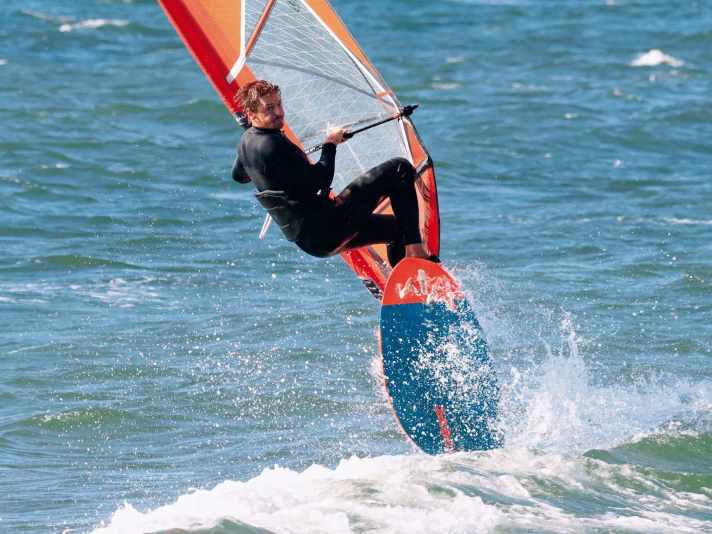
The 3 most common mistakes with the spin loop
Mistake no. 1: Head cinema
Turning into a spin loop is a matter of overcoming obstacles - and it's not uncommon for the moment you jump off, your head starts spinning and all good intentions are gone. Many loop aspirants despair at their own inhibitions, repeatedly abandon their attempts and eventually give up in frustration.
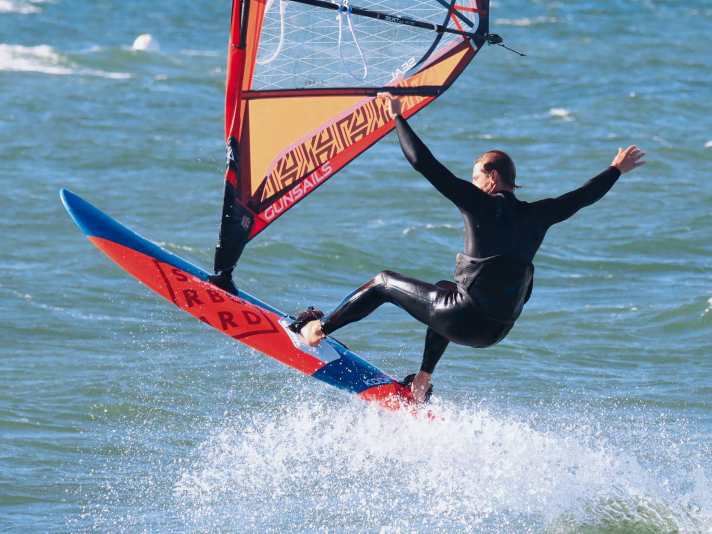
To get out of this endless loop, first rewind to the beginning. Don't put yourself under pressure and take your time. Use the pre-exercises shown to give you the confidence you need to initiate the rotation. The more often you do them, the more natural it will feel for you. Once you feel confident with the pre-exercises, try again. It's best to go out on the water with other windsurfers and do two normal jumps to warm up - and then go for it on the third!
Mistake no. 2: Going astray
Do you keep losing the board when turning in? There can be two reasons for this: Firstly, the lateral grip in the loops is important in order to have secure contact with the board during rotation. If necessary, screw your loops into plugs that don't belong together so that your foot has contact with the loop at the sides.
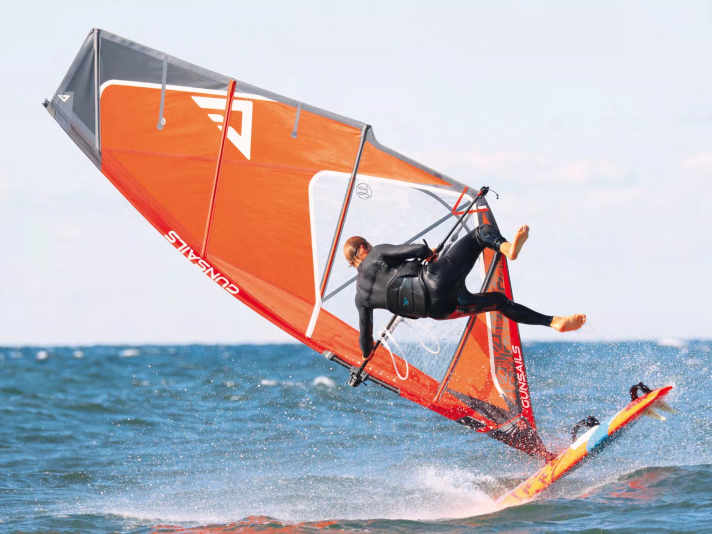
Another reason for losing the board uncontrollably can be that you stick to the water when jumping off. Therefore, try to pick up more speed before the take-off - especially if you want to or have to jump over the back of a wave. Waves that come (diagonally) from the front are more suitable for practising. Even boards with a very flat water position sometimes tend to get stuck when jumping off. By using a slightly larger centre fin or switching from a quad to a thruster setup (if possible), you can give your board more jumping power.
Mistake no. 3: Particle accelerator
Do you rotate, but never manage the complete rotation? There are also two possible reasons for this. If your sail is too small, the rotation will naturally be slower. If you only rotate in slow motion despite having a well-powered sail, this is usually because you are not pulling tight consistently. If your sail hand remains in the normal position on the boom, extreme tightening is hardly possible.
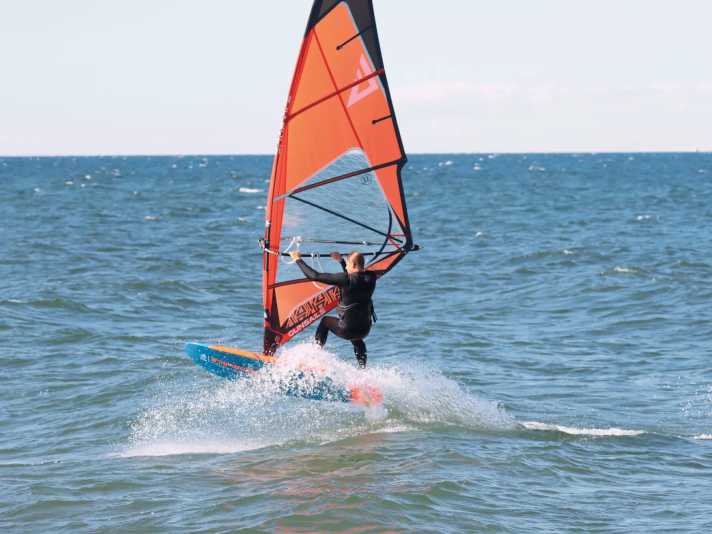
Therefore, move the sail hand far back towards the clew before you take off. If you now take an explosive close reach, you will automatically push the rig past your body with the mast towards the bow and you will be amazed at how much power your sail can suddenly generate.
